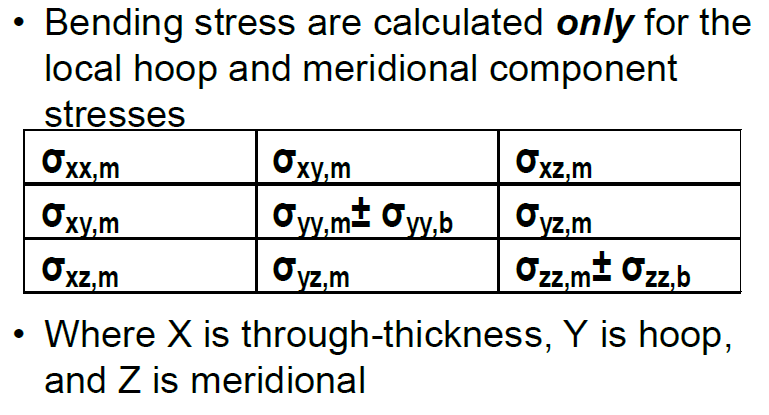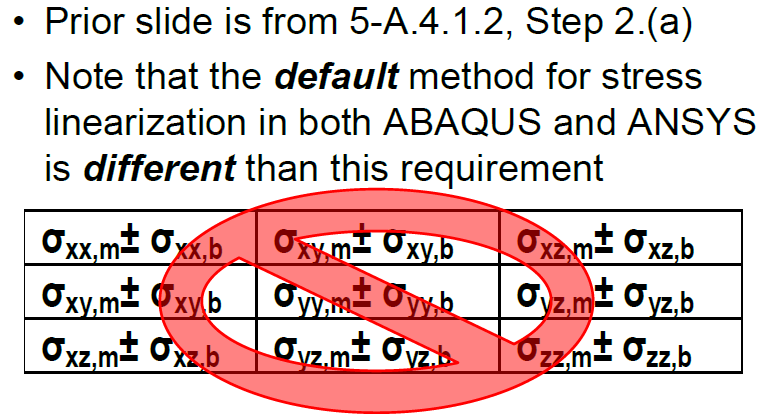Hello Prex/TGS4,
I red your previous posts you wrote regarding ASME SECTION VIII, DIVISION 2 ANNEX 5.A.
I am still not 100% sure how to calculate it
The first two steps of ANNEX 5.A are clear. I am confused how to calculate Bending Stress and Membrane + Bending Stress:
My questions refer to the forum and the following sources:
Membrane Stress
Sm= VonMisesStress of (Snm, Stm, Shm, Tntm, Tnhm, Tthm) = PmV =sigma_ eqvm
All right, all three sources are calculating Membrane Stress with the same formula.
Bending Stress:
In a post here in the forum user Soave posted on Mar 17 calculated the Bending Stress with the formula:
Sb = VonMisesStress (Sbxx, Sbyy, Sbzz, Sbxy, Sbxz, Sbyz)
At pveng.com
PbV = VonMisesStress(Snb, 0, Shb, 0, Tnhb, 0)
First question: According ANNEX 5.A bending stresses should be calculated only for the local hoop and meridional (normal) component Stresses, therefore I think pveng.com used the right formula?
Membrane + Bending Peak Stress:
Suave used sxx at node 1 and subtracted it with the formula that fits to the formula of Annex 5.A. In example min= sxx(0)-(Smxx+Sbxx).
At pveng.com the total Vmises Stress is used.
Second question: If I compare Step 3 of ANNEX 5.A I would say I have to calculate it with the formulas 5.A.3 and 5.A.4. Here Suave is right?
Membrane + Bending Stress:
Suave calculated the Bending Stress with the formula:
Sm+b = VonMisesStress of (Smxx+Sbxx,Smyy+ Sbyy, Smyy+Sbzz, Smxy+Sbxy, Smxz+ Sbxz,Smyz+ Sbyz)
At pveng.com and fsefea.com it is done by:
- Membrane + Bending Stress - end i (+ bending) [->sigma_ eqvmb0]
PmbVi = VonMisesStress of (Snm + Snb, Stm, Shm + Shb, Tntm, Tnhm + Tnhb, Tthm)
- Membrane + Bending Stress - end j (- bending) [ ->sigma_ eqvmbt]
PmbVj = VonMisesStress of (Snm - Snb, Stm, Shm - Shb, Tntm, Tnhm - Tnhb, Tthm)
Here the maximum of one of these two values is the value for Membrane + Bending Stress. I guess this difference is also related to the hoop and meridional component issue.
Last Questions: TGS4 wrote on 2 Aug 16 a tensor, where I can not find + Tnhb. I do have to include Tnhb right?
If I want to visualize Membrane + Bending Stress I draw a line from PmbVi to the Point L=half thickness/height membrane stress and from this point to PmbVj?
Any help would be greatly appreciated. I am a Student from Germany and tried my best to explain. I know my English is not perfect, but I hope anyone can understand.
Best regards
I red your previous posts you wrote regarding ASME SECTION VIII, DIVISION 2 ANNEX 5.A.
I am still not 100% sure how to calculate it
The first two steps of ANNEX 5.A are clear. I am confused how to calculate Bending Stress and Membrane + Bending Stress:
My questions refer to the forum and the following sources:
Membrane Stress
Sm= VonMisesStress of (Snm, Stm, Shm, Tntm, Tnhm, Tthm) = PmV =sigma_ eqvm
All right, all three sources are calculating Membrane Stress with the same formula.
Bending Stress:
In a post here in the forum user Soave posted on Mar 17 calculated the Bending Stress with the formula:
Sb = VonMisesStress (Sbxx, Sbyy, Sbzz, Sbxy, Sbxz, Sbyz)
At pveng.com
PbV = VonMisesStress(Snb, 0, Shb, 0, Tnhb, 0)
First question: According ANNEX 5.A bending stresses should be calculated only for the local hoop and meridional (normal) component Stresses, therefore I think pveng.com used the right formula?
Membrane + Bending Peak Stress:
Suave used sxx at node 1 and subtracted it with the formula that fits to the formula of Annex 5.A. In example min= sxx(0)-(Smxx+Sbxx).
At pveng.com the total Vmises Stress is used.
Second question: If I compare Step 3 of ANNEX 5.A I would say I have to calculate it with the formulas 5.A.3 and 5.A.4. Here Suave is right?
Membrane + Bending Stress:
Suave calculated the Bending Stress with the formula:
Sm+b = VonMisesStress of (Smxx+Sbxx,Smyy+ Sbyy, Smyy+Sbzz, Smxy+Sbxy, Smxz+ Sbxz,Smyz+ Sbyz)
At pveng.com and fsefea.com it is done by:
- Membrane + Bending Stress - end i (+ bending) [->sigma_ eqvmb0]
PmbVi = VonMisesStress of (Snm + Snb, Stm, Shm + Shb, Tntm, Tnhm + Tnhb, Tthm)
- Membrane + Bending Stress - end j (- bending) [ ->sigma_ eqvmbt]
PmbVj = VonMisesStress of (Snm - Snb, Stm, Shm - Shb, Tntm, Tnhm - Tnhb, Tthm)
Here the maximum of one of these two values is the value for Membrane + Bending Stress. I guess this difference is also related to the hoop and meridional component issue.
Last Questions: TGS4 wrote on 2 Aug 16 a tensor, where I can not find + Tnhb. I do have to include Tnhb right?
If I want to visualize Membrane + Bending Stress I draw a line from PmbVi to the Point L=half thickness/height membrane stress and from this point to PmbVj?
Any help would be greatly appreciated. I am a Student from Germany and tried my best to explain. I know my English is not perfect, but I hope anyone can understand.
Best regards


